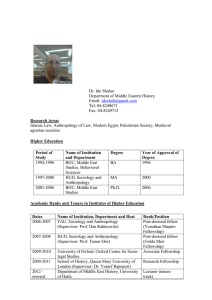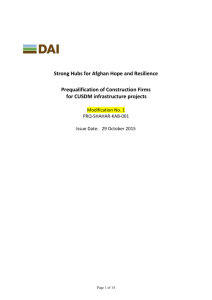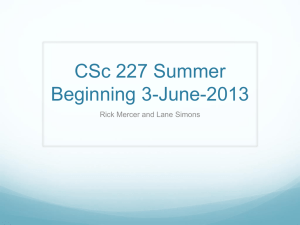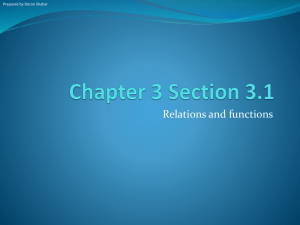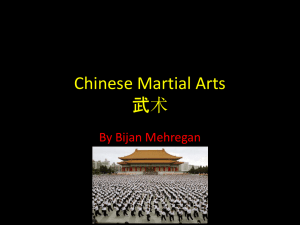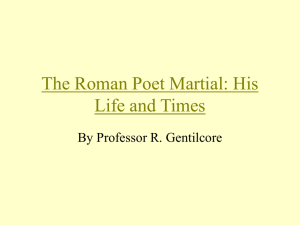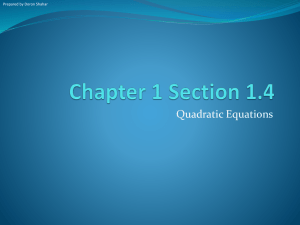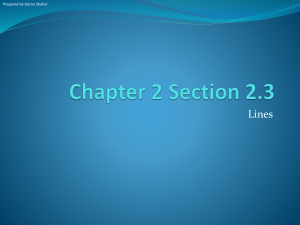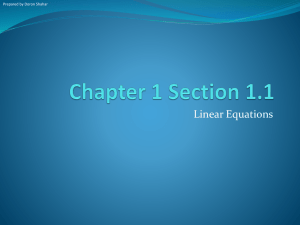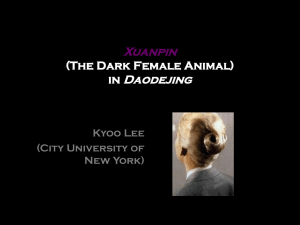Hist 3070 Monks & Warriors syllabus
advertisement
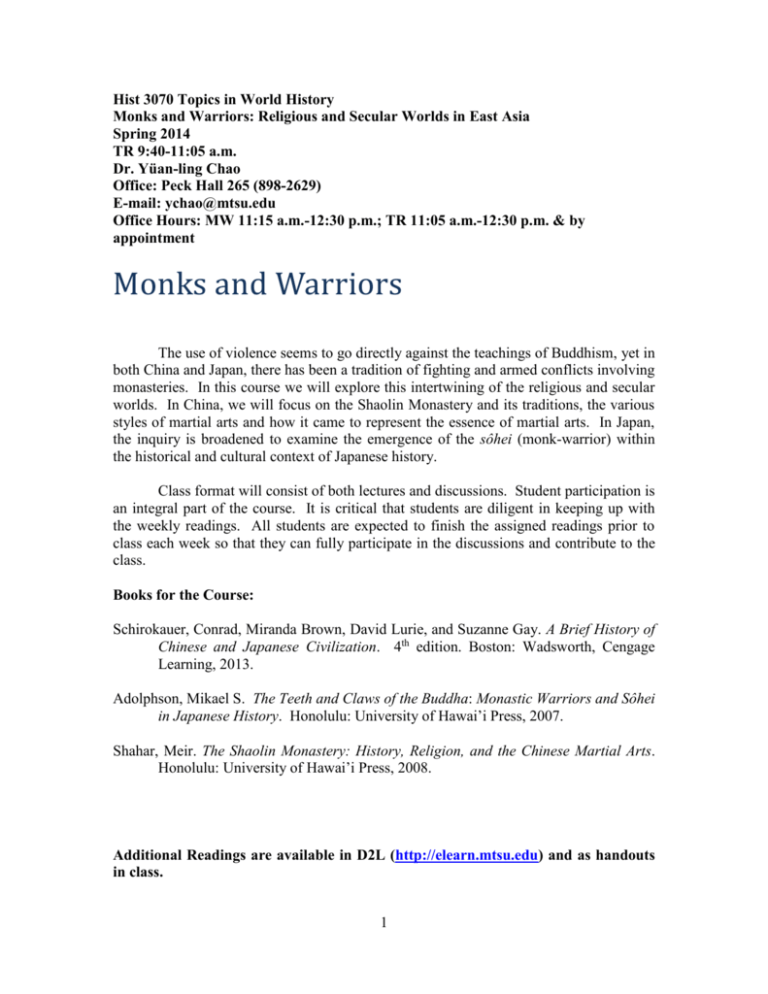
Hist 3070 Topics in World History Monks and Warriors: Religious and Secular Worlds in East Asia Spring 2014 TR 9:40-11:05 a.m. Dr. Yüan-ling Chao Office: Peck Hall 265 (898-2629) E-mail: ychao@mtsu.edu Office Hours: MW 11:15 a.m.-12:30 p.m.; TR 11:05 a.m.-12:30 p.m. & by appointment Monks and Warriors The use of violence seems to go directly against the teachings of Buddhism, yet in both China and Japan, there has been a tradition of fighting and armed conflicts involving monasteries. In this course we will explore this intertwining of the religious and secular worlds. In China, we will focus on the Shaolin Monastery and its traditions, the various styles of martial arts and how it came to represent the essence of martial arts. In Japan, the inquiry is broadened to examine the emergence of the sôhei (monk-warrior) within the historical and cultural context of Japanese history. Class format will consist of both lectures and discussions. Student participation is an integral part of the course. It is critical that students are diligent in keeping up with the weekly readings. All students are expected to finish the assigned readings prior to class each week so that they can fully participate in the discussions and contribute to the class. Books for the Course: Schirokauer, Conrad, Miranda Brown, David Lurie, and Suzanne Gay. A Brief History of Chinese and Japanese Civilization. 4th edition. Boston: Wadsworth, Cengage Learning, 2013. Adolphson, Mikael S. The Teeth and Claws of the Buddha: Monastic Warriors and Sôhei in Japanese History. Honolulu: University of Hawai’i Press, 2007. Shahar, Meir. The Shaolin Monastery: History, Religion, and the Chinese Martial Arts. Honolulu: University of Hawai’i Press, 2008. Additional Readings are available in D2L (http://elearn.mtsu.edu) and as handouts in class. 1 Course Requirements: 1. 5% Attendance (0-1 absence: A; 2-3: B; 4-5: C; 6-7: D; 8 & over: F. Students who arrive more than ten minutes late or leave early will be counted as absent) 2. 10% Participation 3. 35% Two essays (five pages each) 4. 15% Midterm examination 5. 20% class project 4. 15% Final Examination (+/- will be used) A 90 and above B+ 88-89 B 84-87 B- 80-83 C+ 78-79 C 74-77 CD+ D DF 70-73 68-69 64-67 60-63 59 and below Make-up Policy There will be NO make-ups and missed tests and examinations will count as F. Exceptions will only be made in documented cases of emergency and illness. Statement on Cheating Any form of cheating (including plagiarism) on any assignment or examination will result in a grade of “F” for the course and further disciplinary action by the university. “Plagiarize” is defined in Webster’s New Collegiate Dictionary as “to steal and pass off (the ideas or words of another) as one’s own,” “use (a created production) without crediting the source,” “to commit literary theft: present as new and original an idea or product derived from an existing source.” Rules for Classroom Behavior All cell phones should be turned off in the classroom. The use of laptops and tablets to take notes in class is subject to the instructor’s approval. Text messaging is forbidden, and after two warnings, points will be deducted from tests and examinations. Accommodation for Students with Disabilities: If you have a disability that may require assistance or accommodation, or you have questions related to any accommodations for testing, note takes, readers etc., please speak with me as soon as possible. Students may also contact the Office of Disabled Student Services (898-2783) with questions about such services. 2 Lecture and Reading Schedule: Jan. Feb. 16 Introduction Recommended Readings: Schirokauer et.al. Part I 21 Medieval China: Period of Disunion, Sui & Tang Dynasties Schirokauer et.al. Chs. 4 & 5 23 Situating Shaolin: Geography and Religion Shahar, Ch. 1; (D2L) Mark Edward Lewis “The Emergence of a Chinese Buddhism” in China’s Cosmopolitan Empire (Cambridge: The Belknap Press of Harvard University Press, 2009), pp. 214-225. 28 Imperial Patronage: Li Shimin’s military campaigns Shahar, Ch. 2: 20-37 30 Martial Gods and Monks Shahar, Ch. 2: 37-52 4 Ming Dynasty: martial artists and fighting methods Schirokauer et.al. Ch. 10 (Recommended Chs. 8 & 9); Shahar, Ch.3:55-67 6 Monastic Troops and Defense Schirokauer et.al. Ch. 9, 10; Shahar, Ch. 3: 68-81 11 Buddhism and the Use of Staff Fighting Shahar, Ch. 4: 82-99 13 Shaolin staff fighting Shahar, Ch. 4:101-109 18 Hand Combat Techniques and Medicine Shahar: Ch. 5: 113-127; *(D2L)Ted Kaptchek, “The Meridians: The Warp and Woof” in The Web That Has No Weaver (Chicago: Congdon & Weed, 1983), pp. 77-114. 20 Medicine and Martial Arts Shahar, ch. 5: 127-136 25 Daoism, Gymnastics, and Internal Alchemy Shahar, Ch. 6: 137-147; Schirokauer et.al. Ch. 15, 16 27 Daoism, Gymnastics, and Internal Alchemy Shahar, Ch. 6: 147-173; (D2L) Kristofer Schipper, “The Inner Landscape” in The Taoist Body, translated by Karen C. Duval (Berkeley: University of California Press, 1982), pp. 100-112. 3 Mar. Apr. 4 Daoism and Martial Arts Shahar, Ch. 6: 173-181 6 Shaolin monastery and dynastic change Schirokauer et.al. Ch. 15; Shahar, Ch. 7 11 Spring Break 13 Spring Break 18 Martial Arts and Religion 20 Midterm 25 Japan, Introduction Recommended Schirokauer et.al. Ch. 6: pp.53-71; (D2L) Thomas David DuBois, “The Buddha and the Shogun in Sixteenth-century Japan” in Religion and the Making of Modern East Asia (Cambridge: Cambridge University Press, 2011), 27 Religious Violence and Armed Clerics Schirokauer et.al. Ch. 7; Adolphson, Ch. 1 1 Monasteries and Warfare: Succession Disputes Schirokauer et.al. Ch. 11; Adolphson, Ch. 2: 21-51 3 Ashikaga Bakufu and the Rise of Warriors Schirokauer et.al. Ch. 12; Adolphson, Ch. 2: 51-56 8 Monastic Forces: temple warriors Adolphson, Ch. 3: 57-71 10 Monastic Forces: Estate warriors and Jinnin Adolphson, Ch. 3: 71-86; (D2L) Martin Collcutt, “Chinese Émigré Monks and Japanese Warrior-Rulers” in Five Mountains (Cambridge: Harvard University Press, 1981), pp. 57-89. 15 Monk Commanders Adolphson, Ch. 4: 87-105 17 Aristocratic Monk-Commanders Adolphson, Ch. 4: 105-115 22 Benkei Schirokauer et. al. Ch. 14; Adolphson, Ch. 5 4 24 Benkei’ (D2L) Elizabeth Oyler, “Yoshitsune at Koshigoe” in Swords, Oaths, and Prophetic Visions (Honolulu: University of Hawai’i Press, 2006), pp.86114 29 Sôhei, Benkei, and Monastic Warriors Adolphson, Ch. 6 Final Examination May 8 (Thursday) 10:00 a.m.-12:00 p.m. 5
